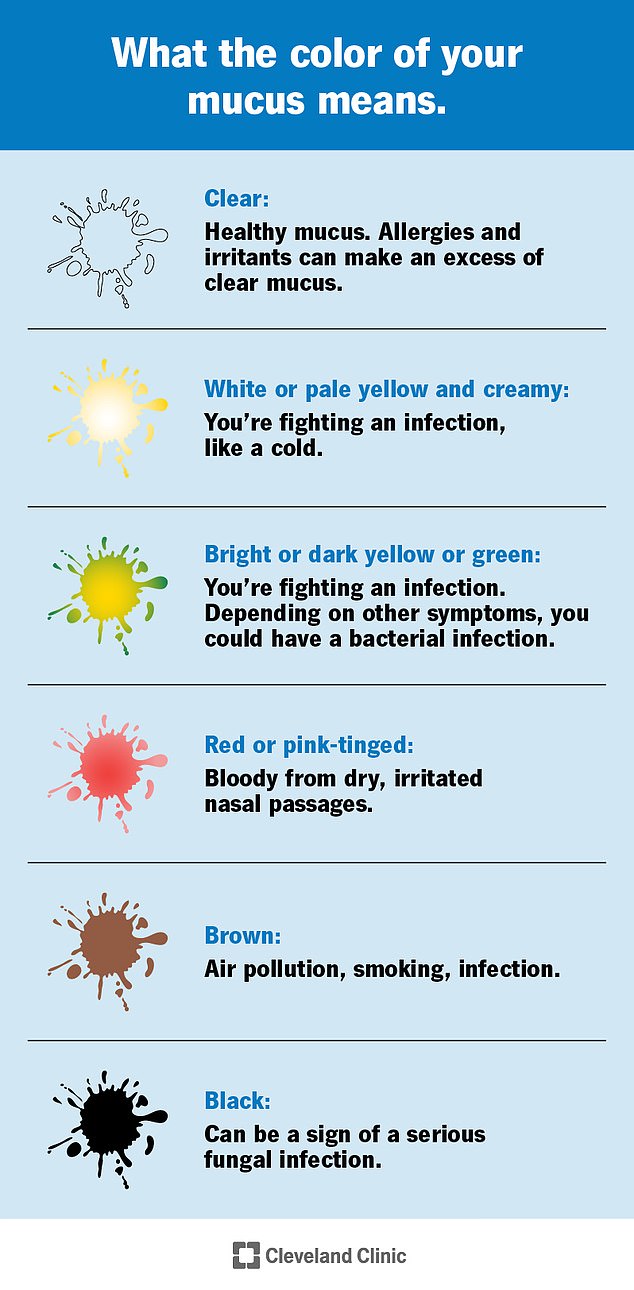However, experts now claim that the color of mucus exiting your nose might indicate concealed signals regarding your well-being.
The human body produces approximately 100 milliliters of mucus daily — which is about 6.5 tablespoons — most of which is swallowed into the stomach, though some also comes out through the nose.
Medical professionals have conducted extensive research on mucus, often referred to as snot, categorizing it into seven different colors. These color variations can provide insights into whether an individual is suffering from an infection, an allergic reaction, or if they are inhaling excessive amounts of polluted air.
"If your mucus is changing color, you should check for other symptoms," Dr Raj Sindwani, an ear, nose, and throat specialist at theCleveland Clinic said.
It's the concept that you were managing well, nothing was troubling you, and then something shifted. You'll need to [consider] what other changes might have occurred.
In general, specialists mentioned that mucus should be transparent in color — showing that all systems are working properly.
However, if this occurrence changes or the mucus becomes more abundant, it might suggest an underlying issue.

Mucus within the nasal passages plays a crucial role in maintaining open airways by capturing dust particles and harmful microorganisms, enabling normal breathing.
It also strengthens the immune system, as the mucus contains antibodies capable of fighting off harmful invaders, and it moistens the air inhaled, helping to keep the airways from becoming dry and irritated.
Among the colors to watch for, medical professionals indicate that white, cream-like, or pale yellow mucus indicates the body is battling a cold or another viral illness, as the white hue results from white blood cells working to eliminate invading pathogens.
When mucus thickens and takes on a yellowish-green color, it indicates that the body is combating a bacterial infection or inflammation in the nasal passages.
Reddish or pink mucus could suggest that a tiny blood vessel in the nasal passage ruptured at some point, and the blood has since dried up.
In addition, mucus that is brown in color may also suggest overexposure to air contaminants or heavy cigarette use, whereas black mucus could mean the body is battling a severe fungal infection.
Experts also suggest that the quantity of mucus generated in the nose might serve as an indicator of an underlying issue.
If an individual's nose generates a significant amount of mucus, this might signal a bacterial infection or an allergic response to pollen - which can lead to increased mucus production in the nasal passages.
In some rare instances, specialists suggest it could also indicate an early symptom of Parkinson's disease.

One of the earliest indicators that individuals with Parkinson's disease experience is difficulty using the muscles in their nose and throat, leading to the buildup of saliva and mucus in their nasal passages, as stated by the Parkinson's Foundation.
Examining an individual's mucus could also provide clues about Alzheimer's disease.
Studies have also found that high levels of amyloid proteins in nasal mucus could suggest that an individual is experiencing Alzheimer's disease.
It is thought that Alzheimer's disease results from the formation of amyloid plaques and tau tangles in the brain, which lead to cell damage and death.
Amyloid protein molecules aggregate within brain cells, creating clusters known as plaques. Meanwhile, tau proteins intertwine into thread-like structures referred to as tangles.
The plaques and tangles hinder the brain's neurons from transmitting electrical and chemical signals between each other.

Gradually, this disturbance results in lasting harm to the brain, which contributes to the development of Alzheimer's disease.
Although it is still unknown how and when the amount of amyloid proteins rises in the nasal secretions of individuals, research has indicated that the detection of these proteins in nasal mucus serves as a distinct indicator for Alzheimer's disease in the brain.
Consequently, researchers point out that analyzing nasal secretions at an early stage to identify specific proteins may aid in delaying the disease's advancement by initiating therapies sooner.
Furthermore, recent studies suggest that analyzing the sticky fluid could also reveal if an individual is prone to developing chronic obstructive pulmonary disease (COPD) – an inflammatory lung condition and the sixth most common cause of death in the United States.
A July 2025 study A study published in the Journal of Allergy and Clinical Immunology revealed that individuals who smoked for many years and had elevated levels of a protein known as IL-26 in their mucus were more prone to developing COPD.
Swedish scientists discovered that elevated amounts of the protein in the lungs and mucus of individuals who smoke indicated reduced lung function and limited respiratory capacity.
Read more

